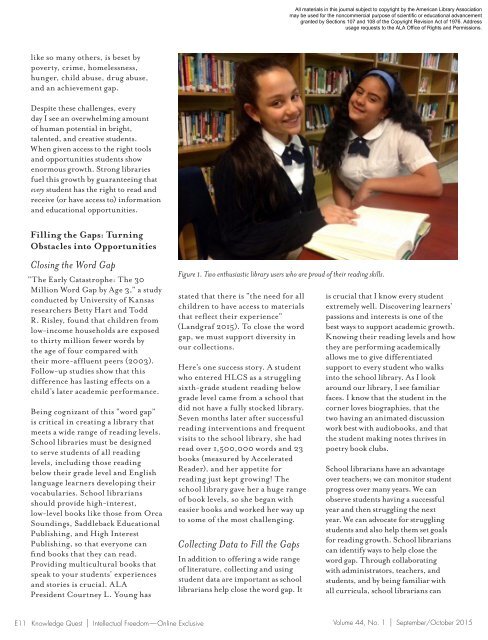School Librarians as Equity Warriors
HRpRj4xy
HRpRj4xy
- No tags were found...
Create successful ePaper yourself
Turn your PDF publications into a flip-book with our unique Google optimized e-Paper software.
All materials in this journal subject to copyright by the American Library Association<br />
may be used for the noncommercial purpose of scientific or educational advancement<br />
granted by Sections 107 and 108 of the Copyright Revision Act of 1976. Address<br />
usage requests to the ALA Office of Rights and Permissions.<br />
like so many others, is beset by<br />
poverty, crime, homelessness,<br />
hunger, child abuse, drug abuse,<br />
and an achievement gap.<br />
Despite these challenges, every<br />
day I see an overwhelming amount<br />
of human potential in bright,<br />
talented, and creative students.<br />
When given access to the right tools<br />
and opportunities students show<br />
enormous growth. Strong libraries<br />
fuel this growth by guaranteeing that<br />
every student h<strong>as</strong> the right to read and<br />
receive (or have access to) information<br />
and educational opportunities.<br />
Filling the Gaps: Turning<br />
Obstacles into Opportunities<br />
Closing the Word Gap<br />
“The Early Cat<strong>as</strong>trophe: The 30<br />
Million Word Gap by Age 3,” a study<br />
conducted by University of Kans<strong>as</strong><br />
researchers Betty Hart and Todd<br />
R. Risley, found that children from<br />
low-income households are exposed<br />
to thirty million fewer words by<br />
the age of four compared with<br />
their more-affluent peers (2003).<br />
Follow-up studies show that this<br />
difference h<strong>as</strong> l<strong>as</strong>ting effects on a<br />
child’s later academic performance.<br />
Being cognizant of this “word gap”<br />
is critical in creating a library that<br />
meets a wide range of reading levels.<br />
<strong>School</strong> libraries must be designed<br />
to serve students of all reading<br />
levels, including those reading<br />
below their grade level and English<br />
language learners developing their<br />
vocabularies. <strong>School</strong> librarians<br />
should provide high-interest,<br />
low-level books like those from Orca<br />
Soundings, Saddleback Educational<br />
Publishing, and High Interest<br />
Publishing, so that everyone can<br />
find books that they can read.<br />
Providing multicultural books that<br />
speak to your students’ experiences<br />
and stories is crucial. ALA<br />
President Courtney L. Young h<strong>as</strong><br />
Figure 1. Two enthusi<strong>as</strong>tic library users who are proud of their reading skills.<br />
stated that there is “the need for all<br />
children to have access to materials<br />
that reflect their experience”<br />
(Landgraf 2015). To close the word<br />
gap, we must support diversity in<br />
our collections.<br />
Here’s one success story. A student<br />
who entered HLCS <strong>as</strong> a struggling<br />
sixth-grade student reading below<br />
grade level came from a school that<br />
did not have a fully stocked library.<br />
Seven months later after successful<br />
reading interventions and frequent<br />
visits to the school library, she had<br />
read over 1,500,000 words and 23<br />
books (me<strong>as</strong>ured by Accelerated<br />
Reader), and her appetite for<br />
reading just kept growing! The<br />
school library gave her a huge range<br />
of book levels, so she began with<br />
e<strong>as</strong>ier books and worked her way up<br />
to some of the most challenging.<br />
Collecting Data to Fill the Gaps<br />
In addition to offering a wide range<br />
of literature, collecting and using<br />
student data are important <strong>as</strong> school<br />
librarians help close the word gap. It<br />
is crucial that I know every student<br />
extremely well. Discovering learners’<br />
p<strong>as</strong>sions and interests is one of the<br />
best ways to support academic growth.<br />
Knowing their reading levels and how<br />
they are performing academically<br />
allows me to give differentiated<br />
support to every student who walks<br />
into the school library. As I look<br />
around our library, I see familiar<br />
faces. I know that the student in the<br />
corner loves biographies, that the<br />
two having an animated discussion<br />
work best with audiobooks, and that<br />
the student making notes thrives in<br />
poetry book clubs.<br />
<strong>School</strong> librarians have an advantage<br />
over teachers; we can monitor student<br />
progress over many years. We can<br />
observe students having a successful<br />
year and then struggling the next<br />
year. We can advocate for struggling<br />
students and also help them set goals<br />
for reading growth. <strong>School</strong> librarians<br />
can identify ways to help close the<br />
word gap. Through collaborating<br />
with administrators, teachers, and<br />
students, and by being familiar with<br />
all curricula, school librarians can<br />
E11 Knowledge Quest | Intellectual Freedom — Online Exclusive Volume 44, No. 1 | September/October 2015


